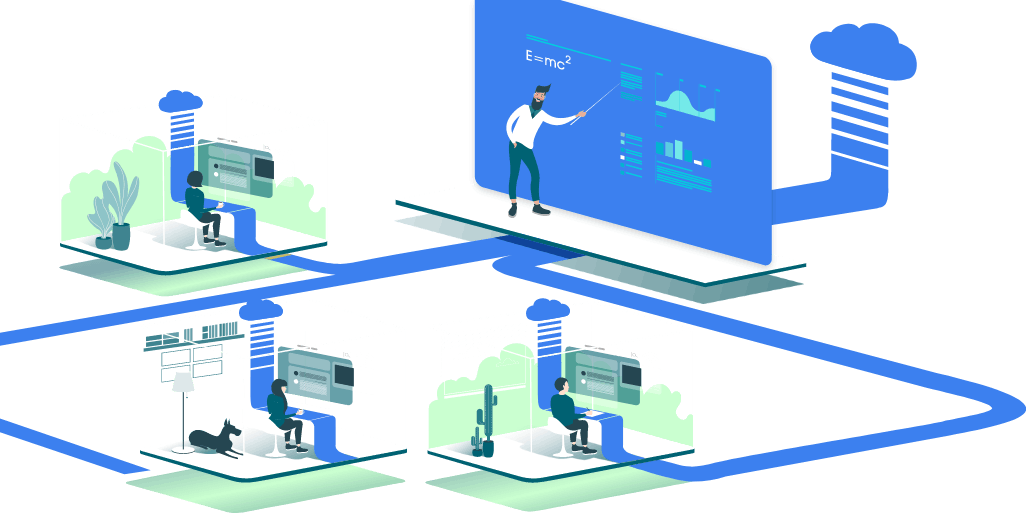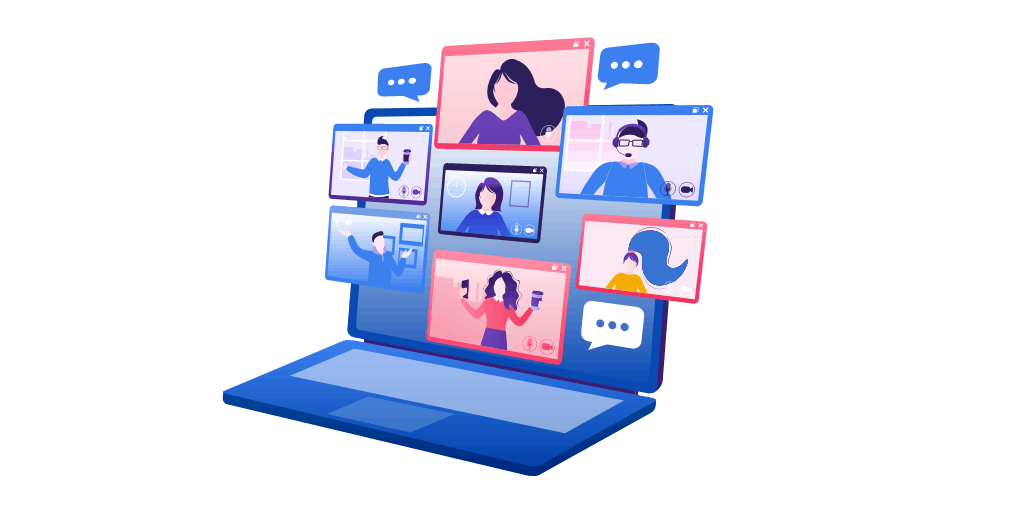Student projects are still important: how to keep collaboration effective, like there's no COVID-19?
author
Lumin staff
published
Apr 15, 2024
categories
Article
read time
5 mins

A sudden transition to a new learning model caused the entire world to think about the best possible ways to introduce advanced technologies to the daily routines of schools and universities. When done correctly, online studies can bring strong benefits to students and educators alike. There are many reviews of the pros and cons of virtual-based classrooms in general, but in this article we will be looking at how students' collaboration can be more effective in an online setting.
Table of Contents
1. Benefits of virtual collaboration
2. Effective collaboration while working on a project
- 1. Benefits of virtual collaboration
- 2. Effective collaboration while working on a project
share this post
It is essential to understand that the offline learning process is different in many ways from the e-learning model; however, both are effective if the parties apply the right strategies and tactics. Educational collaboration involves everyone: the students with their families, an institution's administration, and of course, teachers. It is worth mentioning that with quality collaboration, SaaS tools can significantly contribute to distance learning's overall success.
Benefits of virtual collaboration
Before we dive into some exciting techniques that allow you to get the most out of team collaboration, let’s examine what makes this type of work beneficial.
Stronger teamwork skills
While working in pairs and groups, the teacher can either give students greater autonomy by allowing them to decide by themselves what responsibilities each of the participants will have, or they can assign a specific role to each person. It seems that it is better when children are able to make a decision based on their previous experiences in a group dynamic. Of course, a teacher should monitor and be on hand to resolve any squabbles or problems that are beginning to seriously impact learning within the group.
Teamwork improves communication, problem-solving, and leadership skills. Students also learn to form and defend an argument. In the long run, these activities will help children to master their project management capacities. You will be surprised to see how fast students can adapt to collaborative projects undertaken online.
Today's younger “digital native” generation is adept with gadgets and the internet, thus, it should not pose many challenges to them even if they are doing this type of work for the first time. You can easily find some team collaboration software to make the entire process more fun, engaging, and modern.
Effective time-management
Time-management skills demonstrated by people during this pandemic haven’t been that impressive for several reasons. First of all, many students around the world had to put on hold a range of extra-curricular activities that used to take up much of their spare time. Quarantine left blank spaces in the daily schedules of many people who often didn’t know how to manage their newfound free time effectively.
Secondly, many people have faced the situation where they need to switch to a digital space for the first time. Irritability and stress due to the inability to engage in the work process can be very frustrating. As a result, a person cannot focus on prioritising tasks and ends up wasting time on other smaller or less worthy pursuits.
Assignments related to collaborative work allow the parties involved to strengthen their time-management skills, as every student is a part of something bigger. If one student fails, everyone is likely to feel the effect. Students are more likely to put in effort when they realize it is something that their peers are invested in as well.
Mutual teaching practice
Working with people allows you to share knowledge and find out some new facts and opinions from your partner. As an essential part of all teamwork, every party should be ready to give and receive. In the study process it is no different.
Often, the most extraordinary ideas are the results of long-lasting discussions and even arguments, where different parties insist on their points of view but come to a mutual agreement. Online collaboration tools offer a range of instruments for a better flow of communication and document sharing both from learner-to-learner and learner-to-educator.
Experience with international peers
Some collaboration platforms can help remove boundaries between students. The internet allows users to enjoy educational material that is available in other countries. What’s more, people of diverse nationalities, upbringings, and cultures can work together, bringing new perspectives to common issues.
Some educational institutions support activities that deal with international exchange and cooperation with other schools or universities. This can be time and resource-consuming in the long run, meaning it is much easier to purchase durable software and collaborate online.
Higher self-esteem
While not as high profile as the previous benefits, effective teamwork on a project can significantly improve students' self-esteem. People who share the same goal and work together to achieve it become more confident in their skills and take pleasure from being part of a prosperous project. Through successful teamwork each participant can spur their collaborators to achieve more than they may have felt they were capable of when working individually.
Being a part of the learning community
The COVID-19 situation continues to cause some people to feel isolated and lonely. Daily life in educational institutions is active and noisy in nature, so forcing a young student to stay in front of a monitor without face to face communication can indeed be difficult.
Nonetheless, collaboration software can create an atmosphere of connectedness, even if it’s not exactly the same as the real thing. By using specific apps, communication channels, and video conferencing tools, children learn to perceive their daily activity as a part of a greater digital learning ecosystem.
Tutors can encourage their students to think outside the box, encouraging them to do things like create blogs where they can share a newly acquired skill or some facts from a TED talk they recently watched. Online group discussions are an excellent way to interact with a community of close peers and international mates.
Effective collaboration while working on a project

Know your team
A person who is in charge of a project's completion is likely to know every participant, but this isn’t necessarily the case for the people working on the project. To make sure the project gets started on the right foot, it is important to understand who is who.
Luckily, a group of learners working remotely can use a variety of methods to get to know the people they are completing an assignment with. They can talk on the telephone, participate in a Zoom meeting, or just simply message their fellow students to get an idea of their personalities, strengths and weaknesses.
The task of a teacher, in this case, is to have time to talk one-on-one with each student. Such an approach allows an educator to get to know a student’s learning style and where they may need help. The teacher can then distribute or monitor duties more effectively, knowing the personalities and strengths of each student.
Think-share-discuss and monitor progress
In order to ensure that each participant is pulling their own weight, it is best to give each learner an individual task that they can then bring to a wider project. This ensures that group time is not wasted defining the scope of a task and coming up with initial ideas. The very essence of educational collaboration is the development of your thoughts into an idea and then sharing these thoughts through team collaboration tools.
When a person comes with a ready idea, this can save time for each participant. Importantly, every student should be given a chance to concentrate on something that aligns with their strengths. A teacher knowing their students well is crucial in this regard.
Keep in mind that while the individual work can seem clear and straightforward, the real challenge is taking all the pieces of the jigsaw and putting them into the right place. It would be better to monitor the progress of every person in the group regularly. Based on these meet-ups, it would also be easier to register the overall advancement.
Some collaboration apps provide tutors with an opportunity to create surveys, quizzes, and Q&A tests. Using these features, you can enhance pair work. Consider asking about the levels of comfort, whether a student has all the necessary instruments and data, and if all students have any suggestions regarding virtual collaboration.
Digital brainstorming alternative
Brainstorming is a tactic that is used often in physical classroom settings. For visual learners it can be a valuable activity, but can be difficult to run when working remotely. Online study allows teachers to use a greater toolset, finding innovative ways to shake things up and trigger imaginations. Consider brainwriting as an alternative way to collect the best possible ideas from your learners, as it works regardless of whether a student has problems with internet connectivity or their microphones at a specific time.
An educator can apply specific instruments to begin a brainwriting educational session. Then they are required to think about a suitable topic and inform the participants before the e-lesson. The students’ task is to come up with as many associations and ideas as possible. You may want to use Google Surveys or similar software for students to submit their answers.
What makes the brainwriting approach stand out compared to other methods is the idea of involving every single person equally. Whether the student is a loud group leader or quiet and reserved, they have a chance to announce their top ideas to the entire class. As students submit the answers right before the lesson, you can be sure that they have done their own preparation and are not just copying what someone else has said earlier in the lesson.
Mutual review
Teachers know that peer review is an excellent way to save time and cause learners to think more deeply and critically about the important elements of a particular task. Let students underpin their knowledge and develop their reasoning skills as they judge their peers' work. Of course, teachers need to support students by providing them with guidelines or running a lesson on how to review someone’s work effectively.
While the peer review is taking place, the teacher needs to keep an eye on the whole process to make sure that students are giving proper constructive feedback and not using criticism as a way to bully others. With robust educational software there are tools that can be used to track students’ online remarks and notes.
Peer review is not only useful for the student receiving the feedback, but also for the student giving it. Being able to do things such as explain a challenging concept or grammar rule in their own words is not an easy task, and can help solidify a concept for both parties.
Explain the worth of a project
Every type of learning is more engaging when participants understand why they are doing the project. Everyone wants to understand that there is some worth in the activity they are pursuing, which also goes for tasks in the world of work. Consider group work as something that can lead to a discovery that would be more difficult to make as an individual.
Working on an assignment, students should know the essential questions that they are to answer. More importantly, every member must understand the project's purpose, the big picture, and how their particular duties contribute to the overall task. Working to a common worthy goal like this helps build a friendly atmosphere and boosts camaraderie.
Getting on with learning

Despite countries undertaking vaccination drives, the entire world is still feeling the effects of COVID-19. While we have outlived the most challenging parts of the pandemic, there are still so many things to overcome. Student projects can be a way for students to continue to gain strong value from their education and also feel closer with their peers.
The lack of communication between people can be a severe problem if you do nothing to diversify the virtual classroom routine. Remember to use tried and tested collaboration tools such as Lumin PDF during virtual lessons to foster the most favorable conditions for learners and keep their online collaboration effective. With Lumin you can:
- Review and collaborate in documents created by your peers, annotating and leaving comments where appropriate.
- Create rich multimedia files incorporating images, sound clips, videos and other elements.
- Easily find key sections in a long text using OCR functionality.
- Share with the teacher or tutor at the click of a button and store in the Cloud for access on any device at any time.
share this post